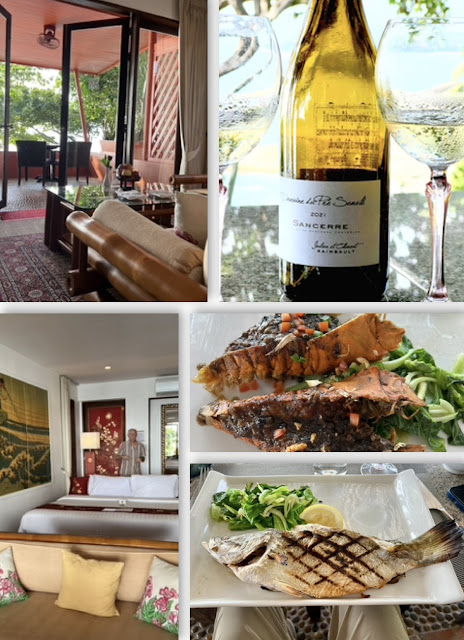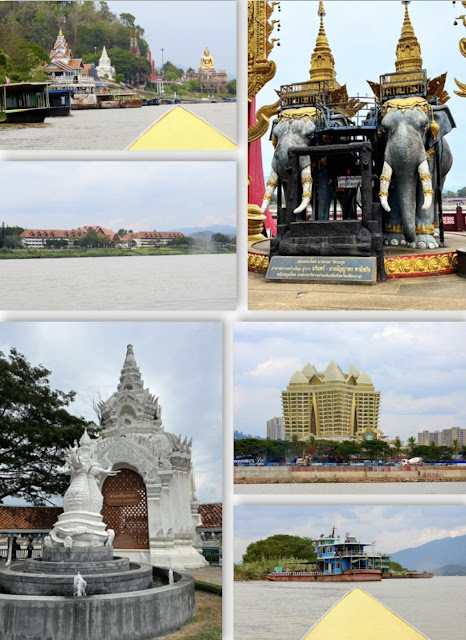Wednesday January 24 / Arrive Phuket
THEN we stayed at Kata Beach Resort which shared Kata Beach with Club Med. It was surprisingly quiet. Now it is packed with beach goers despite the few beach access points. We recall how surprised Jim was to see the European Beach attire (nude tops, and maybe a modest string thong on bottom. You don't see many of those in Maine.) NOW our resort looked down, to the south, at the end of reasonably calm Kata Noi Beach. Busy Kata Beach is to the north and just out of view from our resort. There are so many resorts around Phuket that we are surprised to find we more or less returned to where we stayed before. Another difference. THEN there were few if any vendors around Kata Beach. Now, the street, just across the street from the walled off resorts, is lined with shops and dining options.
Below: James Bond Island rising out of the Bay, the Four of us a little younger, lunch at the Muslim Fishing village.

We arrived at Mom Tri's Villa Royal in mid-afternoon. A lovely resort with a renowned restaurant. We were staying in the Bourgogne Suite in the separate Ocean Wing, a short walk from the larger Beach Wing and the Restaurant. We shared a common area with an indoor / outdoor patio lounge, a pool and a butler with 3 other suites. Our room was basically ready for us but they were pruning the tree over our patio. While we waited the butler took our order for lunch and delivered it to us on the shared patio lounge. The Sancerre went very well with the rock lobster and sea bass.
Mom Tri’s is a gourmet place with an amazing wine list and impressive menu. You can imagine that we are quite happy here.
Thursday January 25 / Phang Nga Bay
We did a repeat trip from Phuket to James Bond Island and to the Muslim Fishing Village, Ko Panyi, for lunch. THEN it was a highlight for us We loved the amazing spicy cooked prawns. NOW It was disappointingly commercial (our travel agent warned us but we had to see for ourselves). While the food was tasty and well prepared, it was not unique at all. The fishing village has grown into a warren of shops with only a few variants from shop to shop.
However this trip added in some cool extras:
- THEN we arrived by Long tailed boat. NOW we were in a speed boat and could cover more territory and had more opportunities to work around the crowds.
- Our first stop of the day was at Laem Had Beach on Ko Yao Yai Island, a lovely powdery sand beach with a sand bar that extends probably 50 yards into the water. We were one of the first two boats to arrive so had the island nearly to ourselves. The crowds would come later.
- The next stop was Ko Lao Bile with a lovely lagoon accessed via a narrow opening in the cliff.
- And Ko Ku Du Yal, another lagoon with a nice sand beach protected by several stone monoliths.
After our lunch at the fishing village we walked around to checkout the shops and see some of the equipment used by the fishermen. After lunch we continued exploring Phang Nga Bay.
- We stopped at Khao Khian to view the ~2,000-year-old Sea Gypsy cave paintings. (Bottom right below: see cute little dolphin and hunters.)
- Then we headed back for a peek at James Bond Island.(Bottom left below.)
- At Ko Hong we boarded canoes and were paddled into and around another lagoon. Interesting rock formations forming cliffs and caves to explore.
- Later, on Ko Pha Nak, we walked along a beach inhabited by monkeys (Top left) and visited a lagoon accessed via a cave tunnel (Center left) only accessible 2 hours a day around low tide. There were interesting walking fish in the lagoon pools (Bottom right).
We returned to Mom Tri's and enjoyed another fine evening meal. In the morning we got our first chance to enjoy their extensive assortment of breakfast foods and condiments.
Friday January 26 / Walk to Kata Beach
We took a walk to Kata Beach and discovered that things had changed significantly. Although the hotel from 30 years ago was still there along side the Club Med there were way more beachgoers than there were 30 years ago.We bought a shirt for Bill but were not generally impressed by the touristy shops and restaurants, nor the total absence of beach view along the street.
Photos below: street sign in downtown Kata Beach, deserted Kata Noi Beach (early morning), Kata Beach crowds.
We went back to Mom Tri's for lunch and a break from the heat.
Saturday January 27 / Central Phuket Downtown Market
Windy, rough weather kept us from having our trip to Phi Phi Island. Instead we went to the Central Phuket Downtown Market, a collection of boutiques and restaurants. Interesting decor. Pretty much the same old same old stores.
Back to Mom Tri's for lunch (Seared sea scallops with lemongrass, fresh Thai herbs, marinated with spicy & sour dressing, Fish & Chips, and a Soft-shell Crab Sandwich accompanied by a Chablis. We followed that with an an afternoon of relaxation. We went to the bar and had a light snack for our evening meal. Tuna nuggets in sesame soy dressing.
Sunday January 28 / Enjoy Mom Tri's and Kata Noi Beach
We had our final day off to relax and enjoy Mom Tri's. We walked to Kata Noi, very quiet in the early morning and never as crowded as Kata.
Two nice meals and a view over Kata Noi at Mom Tri's.
Final observations of THEN and NOW in Thailand:
We recall that Jim noticed lots of bamboo scaffolding on our first trip. We didn’t see any in Thailand. It was all typical modern metal. (Note: Not to reveal too much re India, but we did see bamboo scaffolding there.)
This time, Pat only encountered one squat toilet this trip (although some places are equipped 50/50 squat toilets and western toilets. All were quite clean. Maybe the new cleaner experience relates both to more availability and to our guides knowing where to take us. Or it could be a result of sanitary awareness since Covid. We didn’t think to ask.
Monday January 29 / Off to India












































